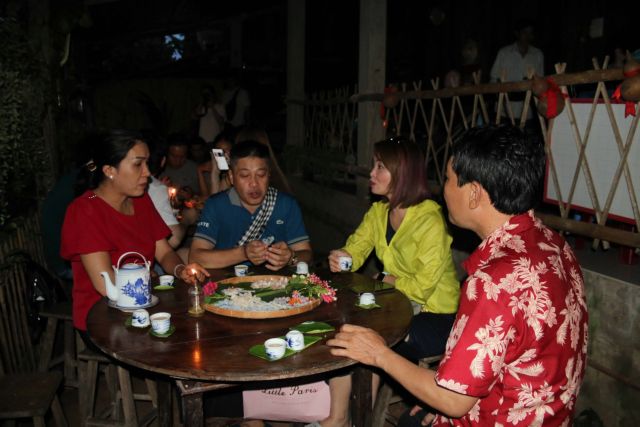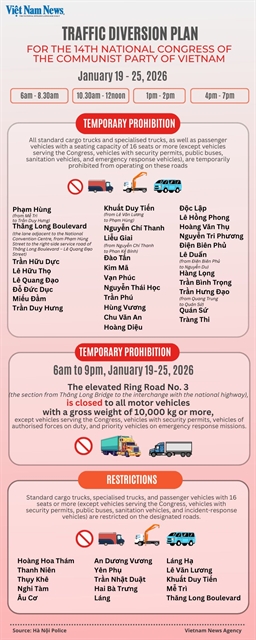 Society
Society

 |
| Tourists eat jam and cakes and drink tea at night under the light of oil lamps in Hô riverine island in Trà Vinh Province’s Càng Long District. – VNA/VNS Photo Thanh Hoà |
TRÀ VINH – The development of community-based tourism products in the Cửu Long (Mekong) Delta province of Trà Vinh has attracted tourists and improved local people’s income.
Hô riverine island in Càng Long District and Chim riverine island in Châu Thành District, for instance, have attracted a large number of tourists.
With the assistance of local authorities and the HCM City Institute for Tourism and Economy Development Research, Hô has provided tourism activities such as night tours without using electricity.
Visiting the island, tourists can experience working as a farmer at day. At night, they have dinner with local people under the light of oil lamps and watch the island by walking on soil paths with the light of oil lanterns.
The island is surrounded by the Cổ Chiên River and has a total area of 22ha and 24 households with a total of 49 people.
It is considered as “a raw pearl” of the province’s tourism, with vast fruit orchards and friendly people.
On Chim riverine island, many households have offered tourism services after receiving the province’s support for tourism development.
Tourists visiting the island can play traditional games, cook local foods, ride bicycles, walk in fruit orchards, row boats, and catch crab, shrimp and fish.
Phạm Thị Sữa, a local on the island, said previously her family lived by doing agriculture but now, under the support of local authorities, her family has offered tourism services.
“We are glad because we have more work to do and have more income, and contribute to preserving and promoting local culture,” she said.
The island has attracted more than 22,000 tourists after launching community-based tourism services in 2019.
Dương Hoàng Sum, director of the provincial Department of Culture, Sports and Tourism, said advocacy activities to enhance the awareness of local people about the development of community-based tourism is an important factor for the province’s success of community-based tourism development.
Located 130km away from HCM City and 80km from Cần Thơ City, Trà Vinh has a coastline of 65km and is located downstream of the Mekong River and between the Tiền and Hậu rivers, two tributaries of the Mekong.
The province has diversified natural tourism resources and cultures. It has many riverine islands with friendly local people and fruit orchards offering year-round harvests
It has a large number of Hoa and Khmer ethnic people and diversified cultures of ethnic people.
The province is home to about 330,000 Khmer people, accounting for 31 per cent of its population, and 143 Khmer pagodas.
The province has many popular tourism destinations such as the Bà Om Pond and Âng Pagoda Complex in the city of Trà Vinh, a 700ha eco-tourism mangrove forest in Duyên Hải District and Tân Quy riverine island in Cầu Kè District.
Bà Om has a total area of 18ha, including 4.2ha pond water surface, and has hundreds of ancient trees.
Built in the 10th century (the year 990), the Âng Pagoda Complex is the province’s oldest and most beautiful Khmer pagoda.
Bà Om Pond and Âng Pagoda Complex were recognised as national cultural and historic heritages in 1994.
Support
Lâm Hữu Phúc, deputy director of the province's Department of Culture, Sports and Tourism, said the province has implemented support policies to develop community-based tourism since 2018.
Individuals, households and companies that offer tourism services in the province will be supported to build infrastructure, renovate handicraft villages and buy vehicles for transporting tourists in 2022-2025.
Households that offer farm-stay services will be provided money for building accommodation rooms, with a maximum amount of VNĐ150 million (US$6,400) for building five such rooms.
The province will also grant VNĐ20 million ($850) for each traditional art performance group or club that performs at tourist sites.
It will also grant VNĐ200 million ($8,500) for each individual, household and establishment to build a restaurant which also sells the province’s specialty products, souvenirs and OCOP products under the country’s “one commune - one product” (OCOP) programme.
The province is calling on investment in nine tourism projects which cost a total of more than VNĐ9 trillion ($390 million).
They include a 368ha ecotourism mangrove forest in Ba Động Beach and a 30ha hot water spring tourism area in Duyên Hải Town; a 50ha ecotourism area in Tân Qui riverine island in Cầu Kè District; a 50ha ecotourism area in Long Trị riverine Island, Bà Om Pond culture-tourism area and the Khmer culture-tourism village in the city of Trà Vinh.
The province aims to develop the Khmer culture-tourism village into a national level culture-tourism destination.
It is also calling for investment to build three hotels ranging from four to five star levels in the city of Trà Vinh. The hotels will cover between 1,200sq.m to 11,400sq.m on State-owned land.
The province aims to attract 550,000 tourists this year, including 10,000 foreigners, up 22 per cent from last year, according to its Department of Culture, Sports and Tourism. – VNS




